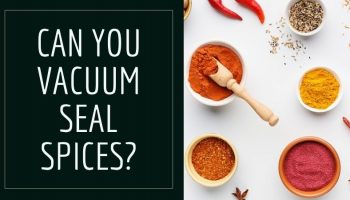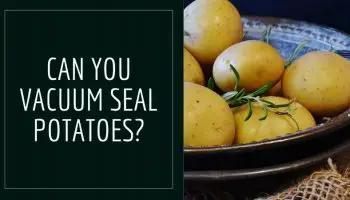Vacuum sealing is a reliable food preservation technique, which can be used on a wide range of products.
The method involves the storage of food in airtight vacuum bags that limit the growth of bacteria and other compounds that may cause the food to go bad.
This technique is mainly used when dealing with meat products, so I’m guessing you are reading this piece because you want to find out if you can apply the method when preserving your veggies.
Well, let’s waste no time and jump right to the big question;
Can You Vacuum Seal Fresh Vegetables?
You can safely vacuum seal fresh vegetables without destroying the nutrients since this preservation method ensures that the food that is in storage maintains all its qualities. As such, your veggies won’t lose their taste, and neither will they discolor.
However, you can only achieve this if you seal the vegetables correctly. Any slight mistake that you make may damage the vegetables.
When it comes to vacuum sealing, preparation is key, so you have to take time to ensure that the vegetables are in good condition before stuffing them inside the vacuum bags.
How to prepare vegetables for vacuum sealing.
You have to keep in mind that preparation procedures vary from one vegetable to another. With that being said, always ensure that you do your research depending on the vegetable that you are dealing with.
However, washing is mandatory for all types of vegetables since this helps in the removal of dirt and other compounds that may cause you harm.
You can also blanch the vegetables to prevent them from losing their flavor, texture, and overall quality while in storage.
Blanching involves the insertion of vegetables in boiling water for a timed interval, after which you can place the veggies in ice water to prevent them from cooking further.
In addition to preserving the qualities of the vegetables, blanching helps in the elimination of surface bacteria and other harmful micro-organisms that may be on the vegetables.
More to this, blanching prevents the vegetables from emitting gasses when they are in storage, meaning that the bags won’t swell up with air.
The vegetables should not be scalded for more than four minutes since this may result in overcooking.
Nonetheless, the timing will depend on the type of vegetable that you are blanching, so some veggies may require more time while others will scald before the four minutes elapse.
Some situations may also require you to chop the vegetables into smaller pieces that you can easily fit inside the vacuum pouches.
Can all vegetables be vacuum sealed?
Not all vegetables can be vacuum-sealed because some are too delicate to survive the process.
Additionally, some vegetables may also promote the growth of bacteria as a result of enzyme reactions, which create conducive conditions for the microbes to thrive.
Some vegetables may also get soggy if they are vacuum sealed, so ensure that you go for the right vegetables before applying this food preservation technique.
What are the advantages of vacuum sealing fresh vegetables?
There are so many benefits that you can gain from vacuum sealing your vegetables as you are about to find out.
Vacuum sealing prolongs freshness and allows the vegetables to stay in good condition for weeks or even months depending on how the products are preserved.
As such, you can comfortably buy your vegetables in bulk without worrying about them going bad.
In addition to this, vacuum sealing can help you save more money in that the vegetables that you buy will never go to waste.
The vacuum sealing process also removes oxygen from the storage bags, thereby minimizing microbial activity.
Consequently, this will prevent the growth of mold and fungi on the vegetables, so your vegetables will always be safe for human consumption.
Through vacuum sealing, you can extend the shelf life of your vegetables up to five times longer compared to when the veggies are thrown directly into the freezer without sealing.
Apart from preserving your veggies, vacuum bags will make your freezer more organized since you will be able to label the vegetables.
How long can vacuum-sealed veggies last?
This highly depends on how the vegetables are prepared prior to vacuum sealing. Vegetables that are poorly prepared will stay fresh for a limited period and vice versa.
Nevertheless, some vegetables will go bad regardless of whether you prepare them well or not, so you should always know the maximum shelf life of each of your vegetables.
Can I vacuum seal different types of vegetables in one bag?
For the vegetables to maintain their freshness, ensure that you seal each type in its own bag to avoid unnecessary complications.
To add to this, the vacuum bag should not be stuffed to full capacity since this increases the chances of it getting torn as the air is being drawn out during the sealing process.
What will happen if vacuum seal garlic or onions?
It is not advisable to vacuum seal these types of vegetables because they have the ability to create perfect conditions for the growth of different types of bacteria, which can potentially be harmful.
Onions and garlic should be used fresh from the farm or immediately after purchase to get all the flavors.
Final Thought
In as much as vacuum sealing is an effective food preservation method, there are several things that you need to consider when dealing with fresh vegetables.
For starters, you have to know the species of vegetable that you are dealing with because this will give you more knowledge on how best you can prepare the products before sealing them.
But most importantly, ensure that you blanch the vegetables that may require you to do so to prevent the enzymes from reacting when the vegetables are in the freezer.
Most cruciferous vegetables require blanching, so you should be prepared to do some extra work when vacuum sealing cabbages, broccoli, kale, turnips, just to mention but a few.
To get the best results from this method, you should consider using the right bags and a reliable vacuum sealer.
| # | Preview | Product | Price | |
|---|---|---|---|---|
| 1 |

|
Chef Preserve Vacuum Sealer (Vacuum... | $99.00 | Buy on Amazon |
| 2 |

|
2023 Updated Vacuum Sealer Machine,... | $25.10 | Buy on Amazon |
| 3 |

|
Nesco Deluxe Food VS-12 Vacuum Sealer,... | $114.57 | Buy on Amazon |
| 4 |

|
FRESKO Smart Vacuum Sealer Pro, Full... | $79.91 | Buy on Amazon |
| 5 |

|
Pyukix Vacuum Sealer Machine, Food... | $89.99 | Buy on Amazon |



![Can You Vacuum Seal Tomatoes? [The Proper Way!]](https://vacuumsealerzone.com/wp-content/uploads/2021/08/Can-You-Vacuum-Seal-Tomatoes-350x200.jpg)